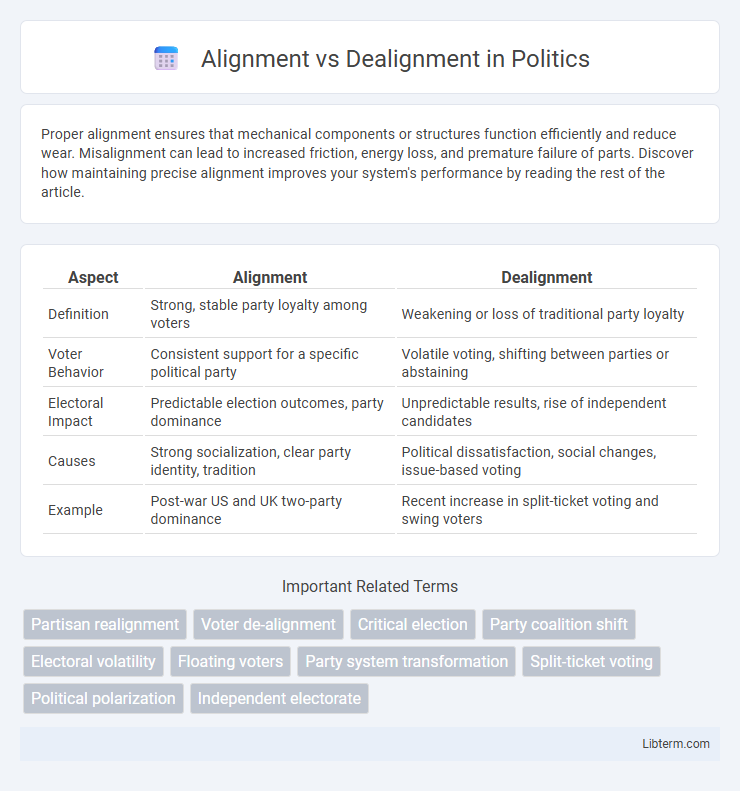Proper alignment ensures that mechanical components or structures function efficiently and reduce wear. Misalignment can lead to increased friction, energy loss, and premature failure of parts. Discover how maintaining precise alignment improves your system's performance by reading the rest of the article.
Table of Comparison
| Aspect | Alignment | Dealignment |
|---|---|---|
| Definition | Strong, stable party loyalty among voters | Weakening or loss of traditional party loyalty |
| Voter Behavior | Consistent support for a specific political party | Volatile voting, shifting between parties or abstaining |
| Electoral Impact | Predictable election outcomes, party dominance | Unpredictable results, rise of independent candidates |
| Causes | Strong socialization, clear party identity, tradition | Political dissatisfaction, social changes, issue-based voting |
| Example | Post-war US and UK two-party dominance | Recent increase in split-ticket voting and swing voters |
Understanding Alignment and Dealignment
Understanding alignment involves recognizing the consistent loyalty between voters and political parties, where shared values and identities create stable voting patterns. Dealignment occurs when voters detach from traditional party affiliations, leading to increased electoral volatility and the rise of independent or swing voters. These shifts affect party strategies and influence election outcomes by altering long-term party support dynamics.
Historical Context of Political Alignment
Political alignment historically shaped voter behavior through strong party identification, often linked to social class, religion, and ethnicity during the early to mid-20th century. Post-1960s, dealignment emerged as voters increasingly rejected traditional party loyalties, influenced by social movements, shifting economic landscapes, and rising political skepticism. This transition reflects changing societal values and the diversification of political issues, leading to more volatile and candidate-centered electoral dynamics.
Key Factors Driving Political Dealignment
Political dealignment is driven by factors such as declining party loyalty, increased voter volatility, and the rise of issue-based politics that transcend traditional party lines. Social changes including generational shifts, media fragmentation, and growing distrust in political institutions also contribute to weakening long-standing political alignments. Economic instability and identity politics further erode the stability of party affiliations, leading to more fragmented and unpredictable electoral behavior.
Alignment vs Dealignment: Core Differences
Alignment refers to the strong connection between voters and political parties, where party loyalty and consistent voting patterns are prevalent, while dealignment indicates a weakening or breakdown of this connection, leading to increased voter volatility and unpredictability. Core differences include the stability of party support in alignment versus the rise of independent or swing voters in dealignment, and the impact on electoral outcomes, with alignment fostering predictable results and dealignment causing fragmented or unpredictable elections. Alignment often correlates with clear party identities and issue affiliations, whereas dealignment is associated with voter skepticism, issue-based voting, and the decline of traditional party structures.
Impact on Voter Behavior
Alignment refers to the strong attachment voters have to a political party, resulting in consistent voting patterns over time. Dealignment occurs when voters become less loyal, leading to increased volatility and a rise in swing or independent voters who evaluate issues and candidates more individually. This shift significantly impacts electoral outcomes by increasing unpredictability and forcing parties to appeal to a broader electorate through targeted messaging and policy adjustments.
Role in Shaping Party Systems
Alignment refers to the strong, stable connections between social groups and political parties, essential for maintaining consistent party systems through voter loyalty and clear party identities. Dealignment describes the weakening of these ties, leading to increased voter volatility and fragmentation in party systems, often resulting in the rise of new political movements or independent candidates. The dynamic between alignment and dealignment significantly influences party system stability, electoral predictability, and the overall structure of political competition.
Consequences for Electoral Outcomes
Alignment solidifies voter loyalty, increasing predictability and stability in electoral outcomes, while dealignment leads to voter volatility, making election results less predictable and parties more competitive. Dealignment often results in the rise of third parties and fluctuating voter bases, which can fragment traditional political landscapes and alter majority thresholds. The shift towards dealignment may also reduce the influence of party identification on voting behavior, emphasizing issue-based or candidate-centered campaigns.
Global Examples of Alignment and Dealignment
Political alignment and dealignment reflect voter loyalty shifts in democracies worldwide, with alignment seen in Germany where consistent support for the CDU/CSU and SPD illustrates stable party identification. Dealignment is evident in the United States, where increasing numbers of voters identify as independents, reducing traditional Republican and Democrat dominance. In India, the rise of regional parties like the Aam Aadmi Party signals dealignment from national parties such as the BJP and Congress, highlighting evolving voter preferences.
The Future of Political Alignments
Political alignments are evolving as traditional party loyalties weaken and voter behavior becomes more issue-driven, signaling a shift toward dealignment. Emerging demographics and digital information ecosystems are accelerating this trend, fostering personalized political identities and issue-based coalitions. Future political landscapes will likely emphasize fluid alignments centered on values and policy preferences rather than fixed partisan affiliations.
Strategies for Navigating a Dealigned Electorate
Navigating a dealigned electorate requires strategies centered on personalized engagement, targeting issue-based campaigning, and leveraging data analytics to identify shifting voter priorities. Political parties must adapt by fostering coalition-building across diverse demographic groups and emphasizing direct communication through digital platforms to counter traditional party loyalty decline. Effective strategies also involve continuous voter sentiment monitoring and flexible policy positioning to remain relevant in a fragmented political landscape.
Alignment Infographic

 libterm.com
libterm.com